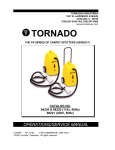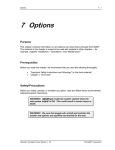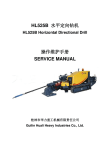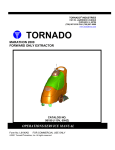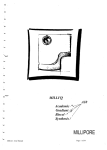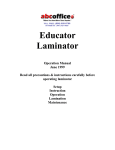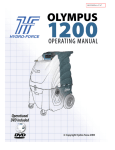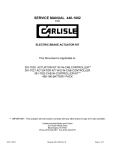Download Service & Operators Manual 417 PULLED
Transcript
58348 JULY 2002 Service & Operators Manual 417 PULLED SCRAPER Table of Contents Foreword…………………………… 2 Safety Section General Safety Information………. 3 Troubleshooting Sequence Valve Adjusting……………. 23 Hydraulic Connections………………… 24 Crushing or Cutting Prevention….. 3 Nomenclature Burn Prevention…………………… 3 Scraper Illustration………………………25 Lines, Tubes, and Hoses………… 3 Special Torques General Section Special Torque Specifications…………26 Specification and Model View…… 4 Serial Number Location…………... 4 Operation Section Before Operating Machine……….. 5 Operating Techniques……………. 6 Top Loading Scraper(s)………….. 8 Parking the Machine……………… 8 Machine Adjustments…………….. 8 Transportation Adjustments……… 8 Maintenance Section Torque Specifications…………….. 10 Tire Inflation Information…………. 11 Lubricating Specifications………... 12 Maintenance Interval Schedule….. 14 Cutting Edges and End Bits -……. 15 Inspect/Replace Draft Arm Wear Plates - …………. 16 Check/Adjust Ejector Carrier Rollers - …………..16 Check/Adjust Ejector Guide Rollers - …………... 17 Check/Adjust Ejector Support Rollers - ………… 17 Check/Adjust Hitch – Lubricate/Inspect………….18 Router Bits – Inspect/Replace…… 18 Tire Inflation – Check……………...20 2 Foreword Noble Construction Equipment products are a result of advanced engineering, skilled manufacturing, and some of the finest materials metallurgical science can select. Thousands of satisfying, economical working hours are built into each machine. For the owner to reach the maximum service from his or her scraper, care must be exercised in its operation and maintenance. The Operator & Service Manual is written to give the operator essential information regarding the day-to-day operation, lubrication, and adjustment of the scraper. Some photos in this manual may show details or attachments that may differ from your scraper. Continuing improvement and advancement of product design by Noble Construction Equipment may cause changes to your machine which may not be included in this manual. Each manual is reviewed and updated, as required, to update and include these changes in later editions. If a question arises regarding your Noble Construction Equipment scraper, or this manual, please consult your Noble Construction Equipment dealer for the latest available information. 3 General Safety Information It is very important to read and understand all safety precautions and warnings before operating and performing lubrication, maintenance, and repair on this product. Failures to observe basic safety rules or precautions cause most accidents involving product operation, maintenance, and repair. Improper operation, lubrication, maintenance or repair of this product can be dangerous and could cause injury or even death. WARNING: It is important to read and understand the operation, lubrication, maintenance, and repair information before operating or performing any lubrication, maintenance, or repair on this product. The information, specifications, and illustrations in this publication are on the basis of information available at the time it was written. The specifications, torques, pressures, measurements, adjustments, illustrations, and other items can change at any time. These changes can affect the service given to the product. Obtain the complete and most current information before starting any job. WARNING: It is important to read and understand the instructions and warnings in the Service and Operators Manual before operating the scrapers. Failure to do so could result in injury or death. Contact any Noble Construction Equipment dealer for replacement guides. Proper care is the responsibility of the owner. Crushing or Cutting Prevention Protective glasses should be worn at all times when servicing scraper(s) to avoid injury to eyes, especially when striking a retainer pin. Chips or other debris can fly off objects when struck. Make sure no one can be injured by flying debris before striking any object. Burn Prevention Personal injury can occur from hot hydraulic oil and components. Do not contact hot oil or components with bare skin. Relieve all pressure before disconnecting hydraulic lines, fittings, or related objects. Tubes and Hoses Do not bend, strike, or install bent or damaged high pressure lines. Repair tubes or hoses that are loose or damaged. Check tubes and hoses carefully. Do not use your bare hand to check for leaks. Use a board or cardboard to check for leaks. Replace the parts if any of the following conditions exist: The end fittings are damaged, leaking, or displaced. The outer covering is chafed or cut. The wire shield is exposed. The outer covering is ballooning locally. Provide adequate support for equipment and support equipment properly when working beneath them. Do not depend on hydraulic cylinders to hold up machine. A piece of equipment can fall if a control is moved, or if a hydraulic line breaks. The flexible part of the hose is kinked or crushed. It is recommended to never adjust the scraper(s) while the scraper(s) is moving unless otherwise specified. Make sure that all clamps and all guards are installed correctly. This will aid in the prevention of vibrations and rubbing parts. Stay clear of all rotating and moving parts. Do not use a kinked or frayed wire rope cable. Wear gloves when handling the wire rope cable. The armoring is embedded in the outer cover. 4 Product Information Section Specifications and Model Views Illustration 3 Noble Construction Equipment scraper serial numbers are located on the left bowl side (driver’s side) just to the right of the draft frame trunnion. Illustration 1 (1) (2) (3) (4) Draft Frame Ejector Apron Bowl Table 1 417 Pull Scraper (17 yd) Overall Length 92.04 m (30.2 ft) Overall Width 35.04 m (11.5 ft) Overall Height 19.7 m (6.5 ft) Weight 9072 kg (20,000 lbs) Serial Number Location Illustration 2 For quick reference, a space is provided below to record scraper serial number. Scraper serial number: 1710S__________ 5 Operation Section Before Operating Machine and the bowl side should not exceed 5.0 ± 1.5 mm (0.20 ± 0.06 in) total, for both sides. Make any necessary repairs. Walk Around Inspection To achieve maximum service life and for personal safety, it is important to make a thorough walkaround inspection of the following scraper(s) areas before operating the scraper(s). Look around and under the machine for such items as loose or missing bolts, trash build up, and hydraulic fluid leaks. Inspect the condition and inflation of the tires, condition of the bowl, hitch, draft arms, and hydraulic components. Illustration 6 3) Check hydraulic tubes and hoses for loose clamps and mounting bolts. Check for worn or frayed hoses. Make any necessary repairs. 4) Check all hydraulic tubes and hoses for damage, excessive wear, and recommended torques. Do not use your bare hands to check for leaks, use cardboard or a board. Illustration 4 1) Check tires for damage and proper inflation. The proper inflation pressure for operating scraper is 47 p.s.i. Replace damaged or worn tubes and hoses. Contact your Noble Construction Equipment dealer for repair or replacement. Illustration 7 Illustration 5 1) Check draft frame cross tube and goose neck for cracks, damage, or distortion. Check for missing or loose draft arm mounting bolts. Make any necessary repairs. 2) Check draft arms for cracks or distortion. The clearance between the draft arm wear plates 5) Check hitches, scraper to tractor and scraper to scraper, for cracks, damage, or distortion. Check for missing or loose bolts. Make any necessary repairs. 6 3) Move ejector to the rear of the bowl and raise apron to desired opening. If using two scrapers move the ejector to the rear of the bowl and raise the apron to desired opening in both scrapers. Illustration 8 6) Check bowl, ejector, and apron for cracks, damage, or distortion. Make any necessary repairs. Note: The ejector should always be moved to the rear of the bowl at the finish of dumping the load. The chance of cylinder damage due to bouncing will be reduced and it sets up scraper for next loading pass. Note: Apron throat opening depends on depth of cut and type of material being loaded. Operators will have to use their judgment on proper throat opening. 4) Maintain tractor engine rpm. Start the cut. 5) Lower the bowl to an efficient cut depth for loading the material. Illustration 9 7) Check cutting edges, router bits, and tips for wear, damage, or missing bolts. Make any necessary repairs. Operating Techniques Loading 1) Load scraper in direction of the fill. 2) When approaching cut, reduce travel speed . Downshift tractor to the proper speed for material being loaded. The average speed for loading is 5 m.p.h. Speeds may vary depending on tractor being used and material being loaded. Note: The cut should be shallow enough to allow the machine to move at a constant speed. If the cut is too deep, the tractor engine may lug. Excessive tire slippage on the tractor may also occur. Decrease the cutting depth if the tractor engine begins to lug or if the tires slip. Use a lower speed if more torque is required at the tractor tires. 6) Gauge the most efficient depth of cut by the depth of the router bits. Use this depth on successive passes. Keep cut area as uniform as possible. 7) Pull the scraper(s) as straight as possible during loading. 8) Do not overload the bowl(s). Overloading the bowl(s) lowers machine efficiency. 9) When the bowl is full, lower apron and raise the bowl simultaneously as you drive forward. Illustration 10 Note: For the best results, allow the apron to be almost closed before raising the bowl. Close the apron the rest of the way as the bowl leaves the ground. This aids in keeping dirt from piling up at the end of a cut. 7 5) If the scraper(s) start to creep while traveling across a hillside, turn the tractor to the downhill side. Likewise, turn the tractor to the downhill side when the scraper(s) is unstable. When you are loaded and you are traveling across a hillside, turning uphill should be done with caution. Illustration 11 10) If using two scrapers, fill front bowl first. As front bowl raises, lower rear scraper ensuring that they are not engage to the ground at the same time. Note: Try to start rear scraper cut at the point where the first scraper was raised. This will provide a more uniform cut area. Note: To minimize down time due to weather, try to maintain a grade which is suitable for good drainage of water. 6) Maintain all haul roads. It is suggested that the haul roads be the width of three machines. Use a grader to maintain the haul roads. A truck for applying water to the road surface is also beneficial in some conditions. 7) Try to avoid making deep ruts in the road. Do not travel in the same track. Travel next to the previous track in order to reduce ruts. Dumping and Spreading Straddle Loading Illustration 13 1) When you arrive at the fill, downshift the tractor in order to maintain the proper engine rpm. Illustration 12 1) If possible, make successive passes leaving short ridges 5 to 6 feet wide the entire width of cut. On succeeding passes, pick up the ridges at a depth below previous cuts. This will leave other ridges, thus repeating the cycle. 2) Dump the material at the highest practical travel speed. 3) Lower the bowl(s) to the desired spread height Traveling Loaded Note: If using two scrapers, both scrapers can be dumped at the same time. 1) Insure that the bowl(s) is raised high enough so that it passes over obstacles. 4) At the start of the dump area, raise apron and move ejector forward. 2) Always travel at a safe operating speed. 5) Finish dumping the load. Slowly raise the bowl(s) in order to leave the dump area smooth. Raise the bowl high enough so that the bowl passes over obstacles. 3) When making turns, reduce the speed of the tractor and scraper(s). 4) Loaded machines have the right away. 8 6) Move the ejector(s) and apron(s) back to precut positions when the bowl has been emptied. 7) Return to the cut at a speed that is suitable for the conditions of the job site. Machine Adjustments Blocking the Bowl Top Loading Scraper(s) The top loading of pulled scrapers by an excavator, a front end loader, or a backhoe was not the original design intent, but has become a common practice in the industry. The success experienced by top loading the scraper(s) has allowed the scraper(s) to stand in for off-road dump trucks. Extreme caution must be taken when top loading the scraper(s) to avoid premature frame and cylinder stress and damage to attachments on the scraper(s). Top loading can cause the following overload conditions: Hitch, Draft Frame Arms, Axle, and Cylinder Stress – To prepare for top loading, the scraper must be lower to the ground. This will relieve the shock or spike pressure when the material is lowered into the bowl. The tractor should also be placed in park and the parking brake set. Exceeding Scraper Capacity – Do not fill above level or struck full when top loading to avoid the following overload conditions: compaction percentage inside the scraper bowl and the weight per cubic yard of wet top loaded material. These conditions can overload or exceed the scraper’s total capacity. Parking the Machine 1) Park on a level surface. If it is necessary to park on a grade, block the wheels securely. Illustration 14 1) Park the machine on level ground 2) Engage the tractor parking brake. 3) Raise the bowl and place blocks under the bowl. Block material should be suitable for carrying the weight of the bowl. 4) Lower the bowl to the block. Block the bowl only to a height so that the bowl can be worked on. Transportation Information Shipping the Scraper Plan your travel route ahead of time and check for overpass clearances. Insure that there is adequate clearance for the scraper(s) that is being transported. Clear loading dock and truck bed of ice, snow, or other slippery material before you load the scraper(s). 2) Engage tractor parking brake. 3) Lower the bowl to the ground. Apply a slight downward pressure. To help prevent the scraper(s) from slipping during transport, remove ice, snow, or other slippery material. Notice: Obey all state and local laws governing the weight, width, and length of a load. 1) Block in front of and behind trailer or rail car wheels before you load the scraper(s). 2) Lower all attachments to the floor of the transport machine. 9 3) Block the scraper(s) tires. Secure the scraper(s) with tie downs. Travel at a moderate speed. Observe all speed limitations when you are roading the scraper(s). Consult your Noble Construction Equipment dealer for shipping instructions for your scraper(s). Roading the Scraper(s) Illustration 16 Recommended tire pressures and speed limitations should be obtained from your tire dealer before you road the scraper(s). Notice: Improper lifting or tie-downs can allow load to shift and cause injury or damage. Limitations for TON-kilometer per hour (TON-mile per hour) must be obeyed. Consult your tire dealer for the speed limit of the tires that are being used. 1) The weights and the instructions that are specified below relate to the scrapers that are manufactured by Noble Construction Equipment Inc. Schedule stops to allow the tires and components to cool when traveling long distances. Stops should be for approximately 30 minutes after every 40 km (25 miles) or after every hour. Obtain the required licenses and authorization by checking with the proper officials before roading your scraper(s). Travel at a moderate speed. Observe all speed limitations when you road the machine. Lifting and Scraper Tying Down the The weight of the 417 scraper is 9072 kg (20,000 lbs). 2) Lifting brackets are located by decals on the machine. 3) Proper rated cables and slings should be used for lifting the scraper. The crane should be in position to lift the scraper in a level plane. 4) Each scraper is equipped with tie-down shipping brackets. Two are located at the front and are called out with decals. Use the cross tube inside the rear frame for rear tie down. 5) Lower the bowl completely before you install the tie-downs. Illustration 15 Illustration 17 6) If shipping two scrapers together, arrange like ‘Illustrations 17’ above. Bowl lift cylinder stops have been provided by 10 Noble Construction Equipment and should be used. Install tie-downs at several locations. Place blocks around tires. Standard Torque Fasteners for Inch Table 2 All of the laws that govern the actual load’s weight, width, and length should be obeyed at all times. Inch Nuts and Bolts Thread Size Inch Standard Torques 1/4 12 ± 3 N·m (9 ± 2 lb ft) 5/16 25 ± 6 N·m (18± 4 lb ft) 3/8 47 ± 9 N·m (35 ± 7 lb ft) Torque Specifications 7/16 70 ± 15 N·m (50 ± 11 lb ft) General Torque Information 1/2 105 ± 20 N·m (75 ± 15 lb ft) 9/16 160 ± 30 N·m (120 ± 22 lb ft) 5/8 215 ± 40 N·m (160 ± 30 lb ft) 3/4 370 ± 50 N·m (275 ± 37 lb ft) 7/8 620 ± 80 N·m (460 ± 60 lb ft) 1 900 ± 100 N·m (660 ± 75 lb ft) Exceptions to these torques are given in the Service Manual, if necessary. 1 1/8 1300 ± 150 N·m (960 ± 110 lb ft) 1 1/4 1800 ± 200 N·m (1320 ± 150 lb ft) Check to ensure that all components are in near new condition before installation of any hardware. Bolts and threads must not be worn or damaged. Threads must be free of burrs or nicks. Hardware must be free of rust and corrosion. Clean the hardware with a non corrosive cleaner. Do not lubricate the fastener threads except for the rust preventative. The rust preventative should be applied by the supplier of that component for purposes of shipping and storage. Other applications for lubricating components may also be specified in the Service Manual. 1 3/8 2400 ± 300 N·m (1780 ± 220 lb ft) 1 1/2 3100 ± 350 N·m (2280 ± 260 lb ft) See your Noble Construction Equipment dealer for shipping instructions for your scraper(s). Maintenance Section WARNING: Possible injury, damage, or malfunction can be caused by mismatched or incorrect fasteners. Caution should be taken to avoid mixing metric dimensioned fasteners and inch dimensioned fasteners. 11 Standard Fasteners Torque for Metric Table 3 Metric Nuts and Bolts Thread Size Metric Standard Torques M6 12 ± 3 N·m (9 ± 2 lb ft) M8 28 ± 7 N·m (21 ± 5 lb ft) M10 55 ± 10 N·m (41 ± 7 lb ft) M12 100 ± 20 N·m (75 ± 15 lb ft) M14 160 ± 30 N·m (120 ± 22 lb ft) M16 240 ± 40 N·m (175 ± 30 lb ft) M20 460 ± 60 N·m (340 ± 44 lb ft) M24 800 ± 100 N·m (590 ± 75 lb ft) M30 1600 ± 200 N·m (1180 ± 150 lb ft) M36 2700 ± 300 N·m (2000 ± 220 lb ft) the slow oxidation of the rubber, slows gradual tire deterioration (important for tires that are expected to have a long service life of at least four years), reduces the corrosion of rim components, and also reduces the problems that result from disassembly. WARNING: Improper tire inflation could result in personal injury or death. Use a self-attaching inflation chuck and stand behind the tread when inflating a tire. Note: The tire equipment regulator should not be set higher than 140 kPa (20 psi) over the recommended pressure. The same tire pressures that are used for air inflation are used for nitrogen inflation. Consult your tire dealer for operating pressures. Table 5 Refer to Service and Operators Manual “Special Torques” for additional torque information Tire Inflation Information Tire Inflation with Nitrogen The use of dry nitrogen gas for tire inflation and for tire pressure adjustments is recommended by Noble Construction Equipment. All machines with rubber tires are included in this. Nitrogen being an inert gas will not aid in combustion inside the tire. WARNING: To avoid over inflation, the proper use of nitrogen inflation equipment and training in the use of that equipment is necessary. Improper or misused equipment can cause a tire blowout or rim failure. Serious personal injury or death can occur due to tire blowout or rim failure. Because a fully charged nitrogen cylinder’s pressure is approximately 15,000 kPa (2200 psi), a tire blowout and/or rim failure can occur if the inflation equipment is not used correctly. Other benefits to using nitrogen in addition to reducing the risk of an explosion include: lessens Size Ply Rating or Shipping Pressure Strength Index kPa psi 29.5 x 25 28 Ply Bias E-3 OTR Tire 324 47 29.5 x 25 22 Ply Bias E-2 Galaxy Tire 324 47 The weight of a ready-to-work scraper without attachments, at the rated payload, and in average operating conditions is the basis that determines the operating inflation pressure. Inflation pressures may differ for each application. Tire air pressure should always be obtained from your tire supplier. Tire Inflation Adjustment Pressure The tire pressure in a warm shop area 18° to 21° C (65° to 70° F) will significantly change when you move the machine into freezing temperatures. If you inflate the tire to the correct pressure in a warm shop, the tire will be under inflated in freezing temperatures. Low pressure shortens the life of a tire. 12 Lubricant Specifications Hydraulic Oil Noble Construction Equipment recommends the use of a hydraulic oil formulated with a balanced additive system. The system should include the following agents: detergents, rust inhibitors, antiwear agents, and defoamers. The hydraulic oil should offer the following benefits: protection against mechanical wear, protection against rusting, and protection against corrosive wear in hydraulic systems. Maximum performance and life of hydraulic system components will be achieved by the use of this hydraulic oil. Applications Hydraulic systems Automotive MPGL grease meets the requirements for extended service intervals of automotive chassis points. This product meets the NLGI certification of “GC-LB”. MPGL grease is available in NLGI Grade 2. Normal operating temperatures for this product are –28° to +149° C (-18° to +300° F). This product is also available as a white lithium complex grease. Oil Analysis The use of an oil analysis program is recommended in order to monitor the condition of your equipment. The oil analysis program will compliment your preventative maintenance program. Commercial Oils Obtaining Oil Samples If the hydraulic oil used by Noble Construction Equipment cannot be used, the following commercial classifications can be used in hydraulic systems. The scraper(s) and tractor should be operated until the oil is well circulated before you obtain an oil sample. Obtain the oil sample. CG-4 engine oils that have a minimum zinc additive of 0.09 percent (900 ppm). CF-4 engine oils that have a minimum zinc additive of 0.09 percent (900 ppm). CF engine oils that have a minimum zinc additive of 0.09 percent (900 ppm). Lubricating Grease Multipurpose Greases Multipurpose Lithium Complex Grease (MPGL) is a general purpose lithium complex grease for mediumduty applications. This product has good characteristics at high temperatures such as dropping point over 260° C (500° F). MPGL grease contains additives and an antiwear inhibitor package. These additives provide extra protection in the following applications. Construction Agriculture The oil sample should not be taken from the drain stream. The drain stream sample method can be contaminated by dirty oil from the bottom of the oil compartment. Also, never dip an oil sample from an oil container or pour a sample from a used tractor filter. Notice: Never use the same vacuum pump for extracting oil samples and coolant samples. The pump may retain a small amount of residue of either type sample which may cause a false positive analysis for the sample being taken. Always use a designated pump for oil sampling and a separate designated pump for cooling sampling. Not doing so could cause a false analysis which could lead to customer and dealer concerns. There are two Noble Construction Equipment approved methods to obtaining oil samples. 13 The following methods are listed in the order that is preferred: Use an in-line sampling valve for pressurized oil systems. Use a sampling gun that is inserted into the sump. The preferred method of sampling is the in-line sampling valve. Contamination is less likely to occur using this method. When you obtain the samples, try to take the samples from the same location. This allows the samples to be more representative of the oil in the system. The oil analysis is composed of four basic test: Wear metal analysis Infrared analysis for oil contamination Test for contamination of the oil by fuel, by water, and/or by antifreeze Particle count for hydraulics Keep in mind when taking the oil analysis, the scraper(s) are using the same hydraulic oil that the tractor is using. Consult your Noble Construction Equipment Dealer or tractor service manual for complete information and assistance about the oil analysis program. Sampling Interval The oil samples should be taken as close to the standard intervals as possible. You must establish a a consistent trend of data to receive the full value from taking oil analysis. Take evenly spaced samples to establish a relevant data history. 14 Maintenance Interval Schedule Note: All safety information, warnings, and instructions must be read and understood before you perform any operation or any maintenance procedure. Before each consecutive interval is performed, all of the maintenance requirements from the previous interval must also be performed. When Required Cutting Edges and End Bits – Inspect/Replace… 14 Draft Arm Wear Plates – Check/Adjust………….. 15 Ejector Carrier Rollers – Check/Adjust………….. 15 Router Bits – Inspect/Replace……………………. 18 Every 10 Service Hours or Daily Hitch – Lubricate…………………………………… 17 Walk-Around Inspection……………………………21 Ejector Guide Rollers – Inspect/Lubricate/ Adjust………………………………………………...16 Every 50 Service Hours or Monthly Tire Inflation – Check……………………………… 19 Every 250 Service Hours or Monthly Ejector Support Rollers – Inspect/Lubricate/ Replace……………………………………………... 16 Hydraulic System Oil Sample – Obtain………….. 20 Wheel Bearing Check – Lubricate/Replace…….. 21 Every 2000 Service Hours or 1 Year Ejector Carrier Rollers – Inspect/Pack/Replace…15 Ejector Guide Rollers – Inspect/Replace………...16 Ejector Support Rollers – Check/Replace………. 16 Hitch – Inspect………………………………………17 Hydraulic System Oil – Change………………….. 20 15 Cutting Edges and End Bits – Inspect/Replace 6) New end bits should be installed if both sides are worn. WARNING: Block the bowl up before changing cutting edges. If the bowl is not blocked up, personal injury or death can occur. 7) Install the bolts and tighten the bolts to the specified torque. See Service and Operators Manual, “Torque for Ground Engaging Tool Bolts.” Notice: Attempting to increase wear life by welding on cutting edges should not be done. Premature failure may result from this. 8) If cutting edge (1) is equipped with ripper teeth, use the following procedure to replace the ripper teeth. Cutting edges need to be changed or rotated before the mounting surface becomes worn. Note: Any material that might fall on the worker should be removed from the sides of the bowl. 1) Park the tractor and scraper(s). Engage tractor parking brake. 2) Raise and block up the bowl. The bowl should be blocked on both sides. Block material should be suitable for carrying the weight of the bowl. The blocked bowl height should only be sufficient enough for the removal of the cutting edges. Illustration 19 9) Drive pin (5) through tip (4) and adapter (3). Remove tip (4) and retainer (6) from adapter (3). 10) Clean pin (5), adapter (3), and retainer (6). Install retainer (6) in the groove in adapter (3). 11) Install a new tip (4) on adapter (3). Install pin (5) through tip (4), retainer (6), and adapter (3). 12) Raise the bowl and remove the blocking. Lower the bowl to the ground. Illustration 18 3) If cutting edge (1) is worn, remove the bolts for cutting edge (1). If the opposite side of the cutting edge is not worn, rotate the cutting edge and install the opposite side of the cutting edge outward. Clean the contact surfaces before installing. 4) New cutting edge sections should be installed if both sides of the cutting edge are worn. 5) If end bits(2) are worn, remove the bolts for end bits (2). If the opposite sides of the end bits are not worn, rotate the end bits and install the opposite sides of the end bits outward. Clean the contact surfaces before installing. 13) The bolts should be checked for proper torque after a few hours of operation. If necessary, tighten the bolts. 16 Draft Arm Check/Adjust Wear Plates – 2) Move eccentric roller shaft (1) to a position that allows the ejector to pass over the top of the floor. 3) Tighten roller shaft clamping bolt (2). 4) Repeat the above procedure to adjust the other ejector carrier roller. 5) Start the tractor engine. Move the ejector forward and backward. Stop the tractor engine. Illustration 20 Inspect the clearance between shim (1) and draft arm wear plate (2). The clearance should be 3 ± 2 mm (0.118 ± 0.080 in). Add shims if necessary. Repeat the procedure for draft arm wear plate on other side of bowl. Ejector Carrier Check/Adjust Rollers Park the scraper(s) on level ground. bowl(s). – 6) Inspect for drag between the ejector and the top of the floor. If necessary, repeat the procedure for adjustment. Ejector Carrier Rollers Inspect/Pack/Replace – Park the scraper(s) on level ground. Lower the bowl(s) and close the apron(s). The two carrier rollers are located at the base of the ejector on the back side. Lower the The two ejector carrier rollers are located at the base of the ejector on the back side. These rollers allow the ejector to ride just above the floor of the bowl without contacting the floor of the bowl at any point. Check the ejector carrier rollers for adjustment. If the ejector carrier rollers are adjusted properly, the ejector does not come in contact with the floor of the bowl. Illustration 22 The debris should be removed from the roller before it is checked. Pack the bearings of the rollers as needed. Illustration 21 1) Loosen roller shaft clamping bolt (2). 17 Ejector Guide Roller Inspect/Lubricate/Adjust Park the scraper(s) on level ground. bowl(s) and close the apron(s). – Ejector Support Roller Inspect/Lubricate/Replace – Lower the Park the scraper(s) on level ground. Lower the bowl(s) and close the apron(s). The two guide rollers are located midway up the ejector back. There is one on each side of the ejector. Ejector support rollers (1) are located at the rear of the ejector. There are two ejector support rollers (1). The rear of the ejector is support by these rollers. The ejector support rollers run in tracks (2). The tracks are located on each side of the frame for the ejector. Illustration 23 Lubricate one fitting on each side of the ejector. Illustration 25 1) All debris should be removed in order to check the roller. 2) Clean grease fitting. 3) Attach a grease gun to grease fitting and apply grease to roller. Repeat the above procedure for the other side. Illustration 24 Clearance between guide rollers and the scraper bowl should be 0.75 to 1.50 mm (0.03 to 0.06 in). 1) The ejector should operate freely without binding. To adjust the guide rollers, loosen the roller shaft clamping bolt (2). 2) Move eccentric roller shaft (1) to position the roller. 3) Tighten the roller shaft clamping bolt (2). 4) Repeat the above procedure to adjust the other ejector guide roller. 18 Hitch – Lubricate Hitch – Inspect Hitch – Tractor to Scraper Hitch – Tractor to Scraper To lubricate the scraper ball that connects to the tractor, locate the grease fitting on the drawbar assembly. The fitting is located on the front right side just under the lip of the drawbar. Illustration 28 1) Inspect retainer plate for wear and cracks. Replace if necessary Illustration 26 1) Clean grease fitting. 2) Inspect retainer plate bolts and washers for wear. Replace if necessary. 2) Attach a grease gun to grease fitting and apply grease to ball. Hitch – Scraper to Scraper To lubricate the scraper ball that connects to the first scraper, locate the grease fitting on the drawbar assembly. The fitting is located on the front right side just under the lip of the drawbar. Illustration 29 1) Inspect drawbar at both ends, tractor pin location and scraper ball location, for wear and cracks. Replace if necessary. Illustration 27 1) Clean grease fitting. 2) Attach a grease gun to grease fitting and apply grease to ball. Illustration 30 1) Inspect draft frame ball (1) for wear. Replace if necessary. 19 2) Inspect draft frame ball for missing, worn, or cracked stops (2). Repair or replace if necessary. be suitable for carrying the weight of the bowl. The blocked bowl height should only be sufficient for the removal of the router bits. 3) Shut off the tractor engine and engage the tractor break. Release the hydraulic pressure on the hydraulic cylinders. 4) Rotating and installing the router bits on the opposite side will allow for double wear. 5) Remove the bolts and remove the router bits. Illustration 31 6) Clean the contact surfaces. 1) Inspect retainer plate for loose or missing bolts. Replace if necessary. 7) New router bits should be installed if both sides of the router bits are worn. 2) Inspect retainer plate for cracks and wear. Replace if necessary. 8) Install the bolts for the router bits and tighten the bolts to the specified torque. See Service and Operators Manual, “Torque for Ground Engaging Tool Bolts.” Router Bits – Inspect/Replace 9) Raise the bowl. Remove the supporting block. Lower the bowl to the ground. 10) The bolts should be checked for proper torque after a few hours of operation. If necessary, tighten the bolts. Illustration 32 WARNING: Block the bowl up before changing router bits. If the bowl is not blocked up, personal injury or death can occur. Router bits need to be changed or rotated before the mounting surface becomes worn. Note: Any material that might fall on the worker should be removed from the bowl area. If the router bits are worn or damaged, they need to be replaced. There is one router bit on each side of the bowl. 1) Park the scraper(s) on level ground. 2) Raise and block up the bowl. The bowl should be blocked on both sides. Block material should 20 Tire Inflation – Check WARNING: Improper tire inflation could result in personal injury or death. Improper or misused equipment can cause a tire blowout or rim failure. Use a self-inflating chuck and stand behind the tread when inflating a tire. To avoid over inflation, the proper use of inflation equipment and training in the use of that equipment is necessary. Install tire on scraper or put tire in a restraining device before inflating tire. Hydraulic System Oil Sample – Obtain Refer to Service and Operators Manual, “Oil Analysis” and Service and Operators Manual, “Sampling Interval” for information that pertains to obtaining a sample of the hydraulic oil. Hydraulic System Oil – Change Notice: Take caution to ensure that all fluids are contained during performance of inspection, maintenance, testing, adjusting, and repair of the product. Before opening any compartments or disassembling any component containing fluids, plan ahead to collect all fluids with suitable containers. All fluids should be disposed of according to local regulations and mandates. Note: The scraper(s) must meet the following conditions before you change the hydraulic tank oil. The scraper(s) and tractor must be level. Illustration 33 Use a tire gauge to measure the pressure of each tire. Nitrogen inflated tires can be checked with a regular tire gauge. Note: Nitrogen gas should be used to inflate scraper tires in order to prevent the tire from exploding. 1) The valve stem should be between the 10 o’clock and 2 o’clock position. 2) Park the scraper(s) on level ground. Apply the tractor parking brake. Lower the bowl(s). Shut off the tractor engine. 3) The area around the valve stem should be clear of all debris. 4) Remove the dust cover for the valve stem. 5) Use a tire gauge to measure the pressure of each tire. Add nitrogen gas if pressure is low. 6) Reinstall the dust cover on the valve stem. Insure that the tractor parking brake is set. The hydraulic oil must be warm. The bowl must be lowered. Check tractor service manual for proper instructions and techniques for draining hydraulic tank. Move ejector(s) to the rear of the scraper(s) and close the apron(s) to ensure that the majority of the dirty hydraulic oil is in the tractor hydraulic tank. Notice: If air has been allowed to enter hydraulic hoses, tubes, or cylinders, bleed hydraulic system by cycling all hydraulic circuits several times before use. If there is a failure in the hydraulic system, unsupported raised equipment could suddenly lower, causing serious personal injury or death. 21 Wheel Bearing Lubricate/Replace Check – 7) Remove wheel hub. Remove outer bearing (5 and 7) as soon as free of axle. 8) Remove inner bearing (4 and 6) from axle. Wheel Bearing – Repacking Wheel bearings should be packed either by hand or by a mechanical bearing packer. Either way ensures that the lubricant is thoroughly worked into the space between the rollers. Lubricant within the bearing gives adequate lubrication, rather than that surrounding it. Do not completely fill the wheel bearing compartment but place a layer of grease 3 to 6 mm (0.125 to 0.25 in) thick on the hub and axle. Take caution not to introduce dirt and grit into the bearing. Mechanical packers and lubricant containers need to be inspected for foreign matter before packing bearings. Wheel Bearing – Replace 9) Wash and inspect bearings and seals. Use new cup and cone if either cup or cone of a set is damaged. 10) Pack bearing cones. Work grease in and around rollers. Clean bearing recess in wheel hub. 11) Install inner bearing (4 and 6) and seal (8). Coat bearing cups with grease. Install hub. Install outer bearing (5 and 7). 12) Install adjusting nut. Tighten until wheel hub seizes. Back off ¼ turn. Wheel must be free rolling without side play. 13) Install lock and locknut (3). Bend lock tangs over outer nut. Pack cavity. Install shim, gasket, and outer cover (2). 14) Install rim and tire. Recheck adjustment. 15) Remove blocking and lower scraper. Walk – Around Inspection WARNING: Personal injury can result from hot oil and hot components. Do not allow hot oil or components to contact skin. Illustration 34 1) Park machine on level ground, lower scraper(s), apply down pressure, set tractor parking brake, raise and block rear of scraper, and stop tractor engine. 2) Remove nuts from rim mounting bolts. 3) Remove rim and tire. 4) Remove axle bearing cover (2), shim, and gasket by removing six bolts. 5) Straighten lock tangs. 6) Remove locknut (3) and lock washer. Notice: Grease and oil that has accumulated on the scraper(s) is a fire hazard. Any time a significant quantity of oil is spilled on the scraper(s) or at least every 1000 hours the debris should be removed with steam cleaning or high pressure water. Note: Watch closely for leaks. If you observe a leak, find the source of the leak and fix it. If you suspect a leak or you observe a leak, check the fluid levels more frequently. 22 5) Check the cutting edges, router bits, and ripper teeth (3) for damage. 6) Check the hydraulic hoses (4) for leaks. 7) Check the tires (5) for any damage and for proper inflation. Replace any missing valve caps. 8) Check all scraper(s). Illustration 35 Illustration 36 Illustration 37 1) Check the hitch and components (6 and7) for cracks and loose or missing bolts. 2) Check the draft frame (2) for cracks, for damage, and for distortion. Check draft frame cross-tube for cracks or for damage. 3) Check the bowl and the ejector (1) for damage and for distortion. 4) Check the tractor hydraulic oil level. of the rollers on the 9) Grease all of the fittings that need to be serviced on a daily basis. 23 Troubleshooting Sequence Valve Adjusting The sequence valve on driver side (lh) of machine is to move the apron (gate) first before the ejector (pusher) moves and sequence valve on ‘passenger’ side (rh) is to return the ejector to load position before the apron lowers. If, when opening the apron, the ejector moves forward or after the apron has opened the ejector does not move, the sequence valve on the driver side requires adjustment. Alternatively, if when the ejector is being returned to loading position and the apron starts to close, the ‘passenger’ side (rh) sequence valve requires adjustment. valve with allen wrench held in place to secure adjustment. Note: On some tractors, the adjustment may not completely eliminate ejector movement. Less than 1” movement during apron raise is satisfactory adjustment. Problem: The apron lowers as the ejector is returning to load position. Solution: On ‘passenger-side’ valve, loosen nut on bottom of valve. Turn screw with allen wrench counter-clockwise until ejector returns to load position and the apron does not move until the ejector has fully returned to the load position. Turn screw at least 1/8 turn counterclockwise past this point. Tighten nut on bottom of valve with allen wrench held in place to secure adjustment. Note: On some tractors, the adjustment may not completely eliminate apron movement. Less than 5” movement during ejector return is satisfactory adjustment. Problem: The apron does not lower or lowers very slowly after the ejector is returned to load position. Illustration 38 Problem: The ejector moves forward as the apron is being raised. Solution: On drive-side valve, loosen nut on bottom of valve. Turn screw with allen wrench counterclockwise until apron raises and the ejector does not move until the apron is fully raised. Turn screw at least 1/8 turn counter-clockwise past this point. Tighten nut on bottom of valve with allen wrench held in place to secure adjustment. Note: On some tractors, the adjustment may not completely eliminate ejector movement. Less than 1” movement during apron raise is satisfactory adjustment. Problem: The ejector does not move or moves very slowly after the apron is raised completely. Solution: On drive-side valve, loosen nut on bottom of valve. Turn screw with allen wrench clockwise until apron raises and the ejector does not move until the apron is fully raised. Turn screw at least 1/8 turn clockwise past this point. Tighten nut on bottom of Solution: On ‘passenger-side’ valve, loosen nut on bottom of valve. Turn screw with allen wrench clockwise until ejector returns to load position and the apron does not move until the ejector has fully returned to the load position. Turn screw at least ¼ turn clockwise past this point. Tighten nut on bottom of valve with allen wrench held in place to secure adjustment. Note: On some tractors, the adjustment may not completely eliminate apron movement. Less than 5” movement during ejector return is satisfactory adjustment. 24 Hydraulic Connections Intermediate Scraper Hydraulics The intermediate scraper is the scraper directly behind the tractor if two scrapers are being pulled. 1) Circuits (5) and (6) control bowl movement on the second scraper. Circuit (5) lowers the bowl and circuit (6) raises the bowl. 2) Circuits (7) and (8) control apron and ejector movement on the second scraper. Circuit (7) raises the apron and then moves the ejector forward. Circuit (8) moves the ejector to the rear of the bowl and then lowers the apron. Trailing or Hydraulics Single Scraper The trailing scraper is the scraper behind the intermediate scraper. It plugs into the hydraulics at the rear of the intermediate scraper. Illustration 39 1) Circuits (1) and (2) control the bowl movement on the first scraper. Circuit (1) lowers the bowl and circuit (2) raises the bowl. If only one scraper is being pulled, the hydraulics plug directly into the tractor as the intermediate hydraulics would. 2) Circuits (3) and (4) control the apron and ejector movement on the first scraper. Circuit (3) raises the apron and then moves the ejector forward. Circuit (4) moves the ejector to the rear of the bowl and then lowers the apron. 3) Circuits (5) and (6) control bowl movement on the second scraper. Circuit (5) lowers the bowl and circuit (6) raises the bowl. 4) Circuits (7) and (8) control apron and ejector movement on the second scraper. Circuit (7) raises the apron and then moves the ejector forward. Circuit (8) moves the ejector to the rear of the bowl and then lowers the apron. The hydraulics for the trailing scraper are routed through the intermediate scraper. They come out at the rear of the scraper and are connected by ORFS fittings. Illustration 41 1) Circuits (5) and (6) control bowl movement on the scraper. Circuit (5) lowers the bowl and circuit (6) raises the bowl. 2) Circuits (7) and (8) control apron and ejector movement on the scraper. Circuit (7) raises the apron and then moves the ejector forward. Circuit (8) moves the ejector to the rear of the bowl and then lowers the apron. Notice: If air has been allowed to enter hydraulic hoses, tubes, or cylinders, bleed hydraulic system by cycling all hydraulic circuits several times before use. If there is a failure in the hydraulic system, unsupported raised equipment could suddenly lower, causing serious personal injury or death. Illustration 40 25 Nomenclature Scraper Illustration 26 Special Torques































